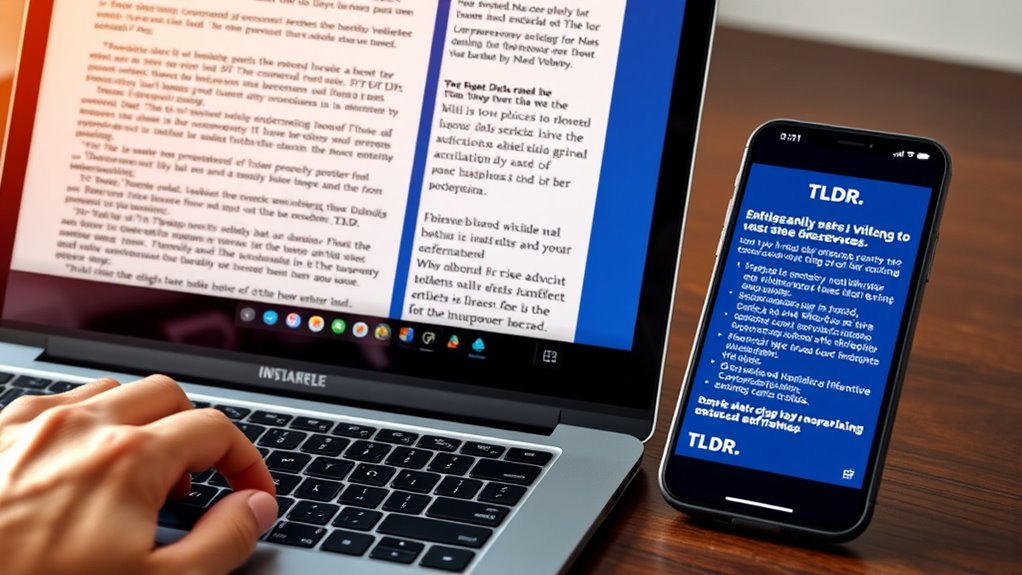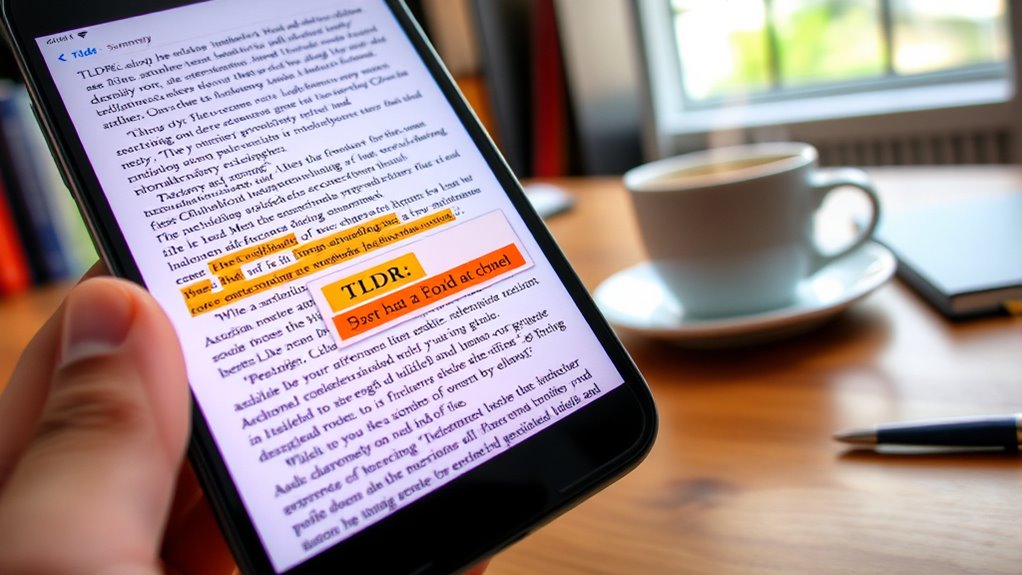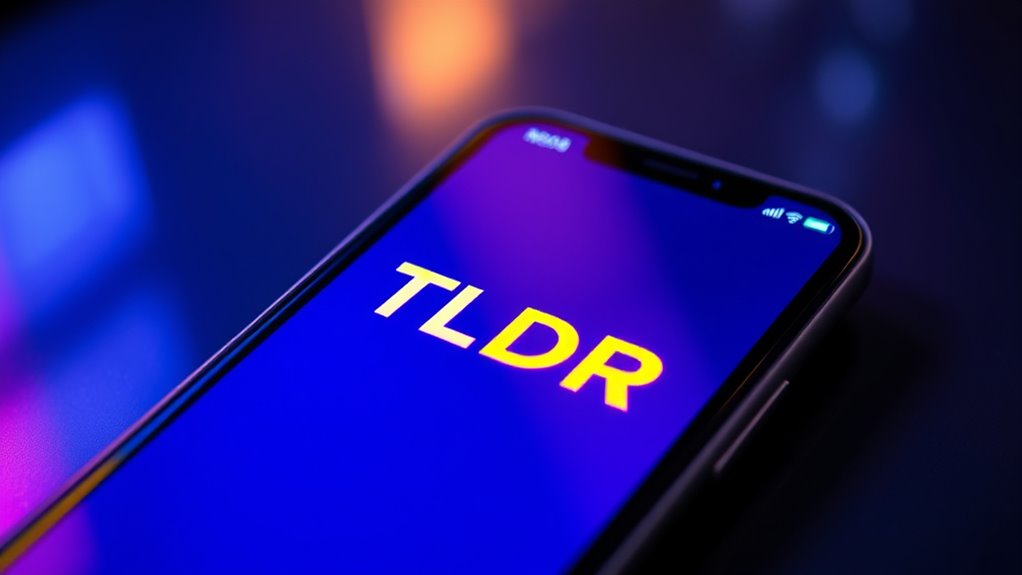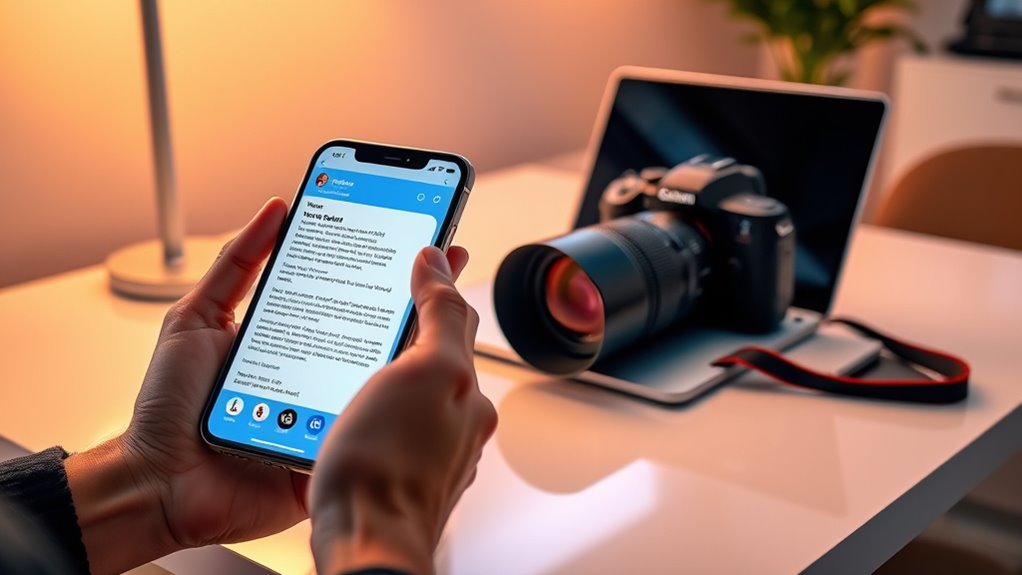TLDR, which means “Too Long; Didn’t Read,” is a quick way to give a brief summary of lengthy content. It helps you understand the main ideas without going through all the details. People often use it online, in social media, or emails to save time and communicate more efficiently. If you want to know how to create effective summaries or discover its different uses, keep exploring more about TLDR.
Key Takeaways
- TLDR stands for “Too Long; Didn’t Read,” used to summarize lengthy content briefly.
- It indicates a quick overview or main points of a longer text.
- Commonly placed at the beginning or end of messages to highlight key information.
- Helps readers decide whether to read the full content by providing a concise summary.
- Originated in online communities to facilitate faster digital communication.
The Origin and Evolution of TLDR

The term TLDR, short for “Too Long; Didn’t Read,” originated on internet forums and message boards in the early 2000s as a quick way to summarize lengthy posts. Its history origins trace back to online communities where users sought efficient ways to convey essential information without reading entire threads. Over time, TLDR’s linguistic evolution expanded from a simple abbreviation to a widely recognized shorthand used across social media, emails, and chat platforms. As digital communication grew faster and more concise, TLDR adapted to serve as a helpful tool for summarization, making it easier to grasp key points quickly. Its transformation reflects how internet slang continuously evolves, blending functionality and brevity in the fast-paced digital world. Additionally, the rise of digital communication has further entrenched TLDR as a common, practical abbreviation for quick understanding.
Understanding the Meaning of TLDR

Understanding what TLDR means helps you grasp how this shorthand simplifies digital communication. Essentially, TLDR provides quick summary insights by condensing lengthy information into key concepts. When you see TLDR, it signals that a brief overview follows, giving you the main points without extra details. This makes it easier to process and decide whether to explore the full content later. Recognizing the meaning of TLDR helps you navigate conversations faster, especially when skimming through articles or social media posts. It’s a handy tool for sharing essential information efficiently, saving time for both the writer and reader. By understanding TLDR, you can better interpret and utilize summarized insights, making your digital interactions more effective and focused on the core ideas. Additionally, knowing how to interpret TLDR can improve your comprehension of content that often includes quick summaries to highlight beneficial information about skincare or beauty routines.
Common Contexts Where TLDR Is Used

You’ll often see TLDR used to provide quick summaries of complex ideas or long articles. It’s also common in informal online chats, where people want to share information efficiently. Understanding these contexts helps you recognize when a quick recap is most helpful. Additionally, TLDR is increasingly used in digital media to highlight AI-generated content and streamline communication.
Concise Summaries of Key Ideas
TLDR is commonly used in online discussions, articles, and emails to provide quick summaries of lengthy content. It helps you grasp key ideas without reading full texts. When using TLDR, you employ summary techniques that focus on core points, boosting reader engagement by making information accessible. Imagine a table that visually captures this:
| Main Idea | Supporting Detail |
|---|---|
| Quick understanding | Saves time |
| Focus on essentials | Maintains clarity |
| Engages readers | Keeps attention sharp |
| Simplifies info | Reduces overwhelm |
| Enhances retention | Reinforces key ideas |
This approach encourages efficient communication, ensuring your audience quickly absorbs crucial information while remaining engaged. TLDR acts as a bridge between complex content and clear understanding, making it a valuable tool for concise summaries. Additionally, mastering summary techniques can improve your ability to highlight the most important points effectively.
Informal Online Communication
In informal online communication, people often use TLDR to quickly share or understand the main point of a message without reading the entire text. It’s a common example of slang abbreviations and online shorthand that saves time and keeps conversations efficient. You’ll see TLDR at the beginning or end of lengthy posts, comments, or discussions to give a brief summary. This usage helps avoid clutter and guarantees everyone gets the gist, especially in fast-paced chats or social media threads. By using TLDR, you signal that you’re providing a quick overview or requesting one, making communication more streamlined. It’s a practical way to handle information overload in digital conversations, emphasizing brevity and clarity.
How to Write an Effective TLDR

To write an effective TLDR, focus on summarizing the main point of the content clearly and succinctly. Use strong summarization techniques like identifying key ideas and eliminating unnecessary details. Your goal is to give readers a quick understanding without overwhelming them. Keep your language simple and direct, emphasizing clarity and brevity. Engage your readers by highlighting the most important information upfront. Avoid vague statements or vague summaries; instead, craft a focused and precise overview. Remember, a well-written TLDR helps readers decide whether they want to explore further, so make it compelling and easy to digest. By honing your summarization skills, you’ll improve reader engagement and ensure your message gets across efficiently. Additionally, employing tools that detect passive voice can help make your summaries more direct and impactful.
Variations and Similar Phrases to TLDR

When sharing summaries or quick overviews, there are several phrases and variations similar to TLDR that can help capture attention and convey the main idea efficiently. These are common summary phrases and abbreviations for summaries used in digital communication. They often appear at the beginning or end of a message to highlight the core information quickly. Some popular options include:
- *Summary:*
- *In brief:*
- *Quick overview:*
- *Key takeaway:*
- *Main point:*
Using these alternatives can make your messages clearer and more engaging, especially when you want to emphasize the most important details without lengthy explanations. They serve as effective tools to ensure your audience quickly grasps the essence of your message.
Tips for Using TLDR in Digital Communication

Using TLDR effectively in digital communication can help you deliver key information quickly and guarantee your audience understands the main point without sifting through lengthy messages. To maximize its impact, pair your TLDR with visual storytelling elements like bullet points, icons, or simple infographics. This not only catches the reader’s attention but also enhances digital literacy by making your message more accessible. Keep your summary clear and focused, highlighting only the most critical details. Avoid clutter and ensure your TLDR complements the full message rather than replacing it entirely. When used strategically, TLDR simplifies complex ideas and makes your communication more engaging and efficient, helping your audience grasp essential information at a glance. Incorporating somatic therapy techniques into your message can also make your communication more relatable and memorable.
The Impact of TLDR on Online Reading Habits

Incorporating TLDR into digital communication has reshaped how people consume online content. It allows you to quickly grasp the main idea, boosting your reading efficiency. However, it also influences your habits by encouraging skimming, which can lead to information overload or missing details. You might find yourself relying on summaries instead of engaging deeply with the full content. This shift impacts your ability to analyze complex topics and retain information long-term. To navigate this, balance is key—use TLDRs when appropriate but avoid sacrificing comprehension. Here’s what you see with this change: faster content consumption, reduced deep reading, increased reliance on summaries, potential for missed details, easier management of information overload, and a possible impact on your understanding of nuanced subjects like Gold IRA investments.
Frequently Asked Questions
When Did TLDR First Become Popular Online?
You’ll find that TLDR first became popular online around 2005, as part of internet slang. Its history origins trace back to online forums and message boards where users wanted quick summaries. As digital communication grew faster, TLDR helped people save time by providing concise summaries. Today, it’s a common way to signal that a brief recap follows, making your messages clearer and more efficient in fast-paced digital conversations.
Are There Formal Alternatives to TLDR?
Think of formal summaries as the polished suits of concise reporting—they’re structured, professional, and clear. Instead of using TLDR, you can rely on phrases like “In summary,” “To conclude,” or “Briefly,” which serve as formal alternatives. These expressions help you deliver information efficiently, like a well-organized roadmap guiding your audience through complex ideas without losing their way. They’re perfect for reports, academic writing, or professional communication.
How Does TLDR Differ Across Different Social Media Platforms?
On different social media platforms, TLDR varies with platform-specific summaries, emojis, and slang usage. For example, Twitter often uses short, punchy summaries with emojis to grab attention, while Reddit favors detailed summaries with less slang. Instagram might see visual summaries or hashtags instead of lengthy text. You’ll notice that each platform adapts TLDR to fit its tone, audience, and content style, making summaries more engaging and relevant.
Can TLDR Be Used in Professional or Academic Writing?
You might think TLDR is just email abbreviations or casual chat, but surprisingly, you can use it in professional or academic writing. It acts as a quick academic summary or a concise way to highlight key points. Ironically, even in formal settings, a well-placed TLDR can save readers time, making it a handy tool to emphasize main ideas without overwhelming your audience with lengthy explanations.
What Are Common Mistakes When Using TLDR?
You often make mistakes with TLDR by overusing it or relying on it as a sole summarization technique. Avoid common abbreviations and guarantee your summary captures the main points clearly. Don’t assume everyone understands TLDR, so provide enough context. Using it improperly can lead to confusion or misinterpretation. Instead, combine TLDR with concise, effective summarization techniques to communicate your message accurately and efficiently.
Conclusion
In the digital symphony of quick bites and swift scrolls, TLDR acts as your guiding star, slicing through the noise like a razor-sharp comet. Embrace it as your trusty compass, steering readers effortlessly through oceans of information. Mastering TLDR transforms you into a linguistic alchemist, turning lengthy tales into sparkling nuggets of clarity. So, wield this tool wisely, and watch your messages shine brighter amidst the chaotic cosmos of online communication.









